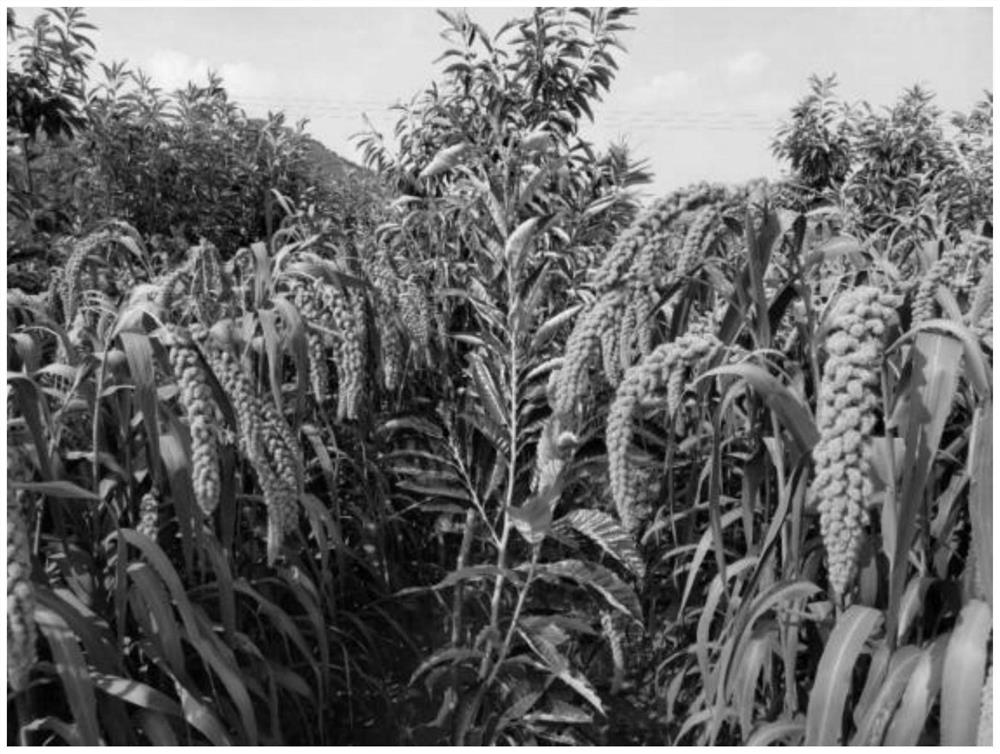Castanea mollissima-shade-tolerant millet three-dimensional interplanting method with synergistic and consistent key growth stages
A development stage, chestnut technology, applied in the direction of biochemical equipment and methods, botany equipment and methods, microbial measurement/inspection, etc., can solve the problems of poor firmness, low yield per mu, idle land, etc., and achieve a good society and economy benefit effect
- Summary
- Abstract
- Description
- Claims
- Application Information
AI Technical Summary
Problems solved by technology
Method used
Image
Examples
Embodiment 1
[0068] Example 1. Identification and screening of shade-tolerant millet germplasm resources.
[0069] From 2015 to 2016 in Qianxi, the method of planting the test materials in the field and under the 10-year-old chestnut tree at the same time was used to measure the performance of plant height, fruitiness, photosynthetic efficiency and yield of 153 germplasm resources, and conduct a comparative analysis. Nine new cultivars / germplasm resources with good shade tolerance were screened out from "Jigu 32, 56229, 3495, 51950, 56950, JK4-95, HK229, 56A, 51A". These materials were planted under 10-year-old chestnut trees. Compared with the field, the photosynthetic rate did not decrease slightly, and the plant height and fruiting were almost unchanged. However, other materials showed a large decrease in photosynthetic rate, and due to lack of sunlight, the plant height increased significantly, and the fruitiness decreased significantly.
[0070]Table 1 The shade-tolerant identificati...
Embodiment 2
[0073] Example 2. Mining of shade-tolerant genes and development of markers.
[0074] Using the shade-tolerant germplasm resources Jigu 32 and JK4-95 screened in Example 1 and the non-shade-tolerant germplasm resources Jigu 31 and FK-1 as materials, the leaves of the three-leaf sword were selected at the booting stage in mid-July 2016, and passed RNA-Seq to obtain their transcriptome information; through the differential expression analysis of the genes of the two types of materials, the differentially expressed genes were obtained; through bioinformatics analysis and evolution analysis, their functions were further speculated; some of the genes with prominent functions were cloned; Through gene sequencing, ascertain its gene sequence and develop a series of shade tolerance markers.
Embodiment 3
[0075] Embodiment 3, creation of shade-tolerant breeding material (sterile line, restorer line)
[0076] Use the shade-tolerant resources screened in Example 1 as materials to prepare a series of hybrid combinations; use the series of shade-tolerant molecular markers developed in Example 2 to create shade-tolerant sterile lines and restorer lines through molecular marker-assisted selection.
[0077] 1) Creation of shade-tolerant CMS lines: In the summer of 2016, 56A and 51A were used as female parents, and KM200 and KM117 were used as male parents to prepare the first generation of hybrids; in winter 2017, Datong 29 and 206083 were used as female parents, The first generation of hybrids formulated in summer was used as the male parent, and the three-cross combination was continued to be prepared. Then, after four consecutive generations of south-to-north breeding, and based on molecular markers, the shade-tolerant offspring were selected to breed new CMS lines DZ40A and DZ386A....
PUM
 Login to View More
Login to View More Abstract
Description
Claims
Application Information
 Login to View More
Login to View More - R&D
- Intellectual Property
- Life Sciences
- Materials
- Tech Scout
- Unparalleled Data Quality
- Higher Quality Content
- 60% Fewer Hallucinations
Browse by: Latest US Patents, China's latest patents, Technical Efficacy Thesaurus, Application Domain, Technology Topic, Popular Technical Reports.
© 2025 PatSnap. All rights reserved.Legal|Privacy policy|Modern Slavery Act Transparency Statement|Sitemap|About US| Contact US: help@patsnap.com



